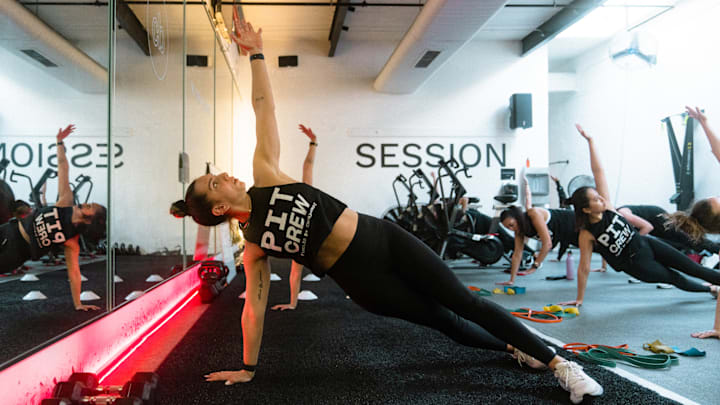Whether you hit the gym regularly or prefer casual runs around the neighborhood, it’s important to take care of your body and make sure you’re doing everything you can to alleviate muscle aches and pains that can come from exercising.
Exercising regularly helps prevent chronic diseases such as obesity, type 2 diabetes, certain types of cancer, depression, and cardiovascular disease, among other ailments—and can even improve one’s mental health. Maintaining an active lifestyle often leads to a longer lifespan, too. And the fitness routines you build today will likely lead to a better and healthier future—preferably without any injuries. With that in mind, Mental Floss and Cheribundi have rounded up five easy ways to cut down on muscle soreness after a workout.
1. Stay hydrated.
Whatever you do, make sure you’re drinking enough fluids before, during, and after your workout so you don’t become dehydrated. Staying adequately hydrated helps to keep your system going by relieving inflammation and helping sore muscles recover more quickly after periods of prolonged activity. Losing fluids by sweating is a normal part of the exercise process, and drinking fluids such as water and other performance beverages throughout your workout ensures your body is getting what it needs to function.
2. Consider tart cherry juice as part of your daily recovery routine.
While water is the beverage many people reach for while working out, at least one study has shown that nutrients in tart cherry juice—which is loaded with phytonutrients, the same natural chemicals that protect plants from bugs, fungi, and pathogens—can help reduce muscle inflammation in marathon runners who were practicing endurance training, making it a great post-workout beverage choice. After drinking 16 ounces of tart cherry juice for a total of eight days before and after participating in a marathon, runners experienced 49 percent less inflammation compared to a placebo group. Another study found that older adults with insomnia who drank cherry juice twice a day for two weeks enjoyed 90 more minutes of sleep.
3. Treat your muscles to a massage.
After a tough workout, give your muscles a break with some self-myofascial release. Assist with muscle recovery and restore range of motion in your joints by using a foam roller to relieve tension in your back, calves, hamstrings, quadriceps, or any muscles that might be feeling tight following your workout. Rollers are typically available in varying densities and designs and may have additional features for deep tissue massages. Go with whatever feels best for your particular needs.
In a pinch, a tennis ball can also be used to achieve the same effect of self-myofascial release. Simply lie on the floor, place a tennis ball under your lower back, upper thigh, or butt muscles, and gently move around to let it roll over and release tension in any trouble spots. Don’t forget to show your feet and lower legs some love: Applying pressure while rolling a tennis ball under each foot can help stretch out your calves and hamstrings and enhance flexibility in your lower back.
4. Mix up your workout routine so you don’t overdo it.
Variety is the spice of life, as they say, and that goes for exercise as well. Avoid overdoing it by building different workout styles into your weekly routine. Cardio is a great way to achieve your fitness goals, but remember to give your muscles the break they deserve by sticking to resistance training—or other, lighter exercises—on off-days. Zen out with some yoga, go for a long walk, take a swim, or go on a leisurely bike ride to cool things down while still remaining active. Mixing things up allows your muscles to get plenty of rest so they can fully recover before your next round of strenuous activity, especially if you’re not using the same muscle groups to do the same vigorous workout every day.
5. Stretch out—or do some mild exercises—after your workout.
While there are generally mixed opinions among the scientific community when it comes to the benefits of stretching before you begin working out versus after you’re finished, most studies show that doing some sort of warm-up before more intense activity helped to reduce soreness later—though the effects really didn’t become apparent until several days after exercise. An active cool-down following a vigorous workout, meanwhile, could improve blood flow to muscles, which can remove metabolic byproducts that can cause soreness.
Cheribundi tart cherry juice is packed with powerful antioxidants, phytonutrients, and anti-inflammatory properties that numerous studies have shown can significantly cut down on muscle soreness after workouts. In addition, this all-natural fuel also takes advantage of the melatonin found in tart cherries to help promote deeper, more restful sleep at night to help your body recover. Scientifically proven to significantly improve overall mental and physical health, Cheribundi’s purpose is to fuel daily progress and is currently being used by nearly 400 professional and collegiate sports teams in the U.S. today.
